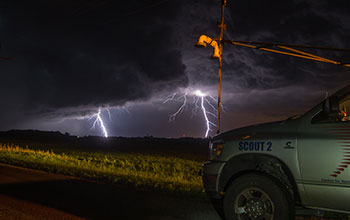Multimedia Gallery
Cloud-to-ground lightning and PECAN vehicle during nighttime thunderstorm
A vehicle with the Plains Elevated Convection at Night project is seen in the foreground as cloud-to-ground lightning strikes nearby during a nighttime thunderstorm in the Midwest.
More about this image
In summer 2015, atmospheric scientists participating in the PECAN project fanned out across the Great Plains in an effort to better understand the atmospheric conditions that lead to storm formation and evolution after sunset. Results gleaned from this research may ultimately help improve forecasts of these sometimes damaging storms. The project, which is largely funded by the National Science Foundation (NSF), involved scientists, students and support staff from eight research labs and 14 universities.
Daytime thunderstorms are more easily understood than those that occur at night. In the day, the sun heats the surface of Earth, which in turn warms the air directly above the ground. When that warm air is forced to rise, it causes convection -- a circulation of warm updrafts and cool downdrafts -- and sometimes creates a storm.
"At night, the entire storm circulation is elevated higher off the ground," said National Center for Atmospheric Research scientist Tammy Weckwerth, a PECAN principal investigator. "This makes observations of the conditions leading to nighttime thunderstorms much more challenging because that part of the atmosphere is not well covered by the network of instruments we normally rely on."
To help tackle this problem, PECAN researchers used lab-equipped aircraft, ground-based instruments and weather balloons to collect data higher in the atmosphere. The data will help scientists characterize the conditions that lead to individual storm formation, as well as to the clustering and organizing of these storms into large-scale systems, which can result in significant precipitation.
The researchers say the PECAN project will provide researchers and operational forecasters with valuable insights into thunderstorms at night and improve the ability to model them more accurately. [Research supported by NSF grant AGS 1237404.]
Learn more about PECAN in the NSF Discovery story 10 things to know about thunderstorms that strike at night; or see NSF press release Scientists tackle mystery of thunderstorms that strike at night. (Date image taken: summer 2015; date originally posted to NSF Multimedia Gallery: Nov. 24, 2015)
Credit: Jacob DeFlitch, Meteorologist
Images and other media in the National Science Foundation Multimedia Gallery are available for use in print and electronic material by NSF employees, members of the media, university staff, teachers and the general public. All media in the gallery are intended for personal, educational and nonprofit/non-commercial use only.
Images credited to the National Science Foundation, a federal agency, are in the public domain. The images were created by employees of the United States Government as part of their official duties or prepared by contractors as "works for hire" for NSF. You may freely use NSF-credited images and, at your discretion, credit NSF with a "Courtesy: National Science Foundation" notation.
Additional information about general usage can be found in Conditions.
Also Available:
Download the high-resolution JPG version of the image. (8 MB)
Use your mouse to right-click (Mac users may need to Ctrl-click) the link above and choose the option that will save the file or target to your computer.



 All images in this series
All images in this series